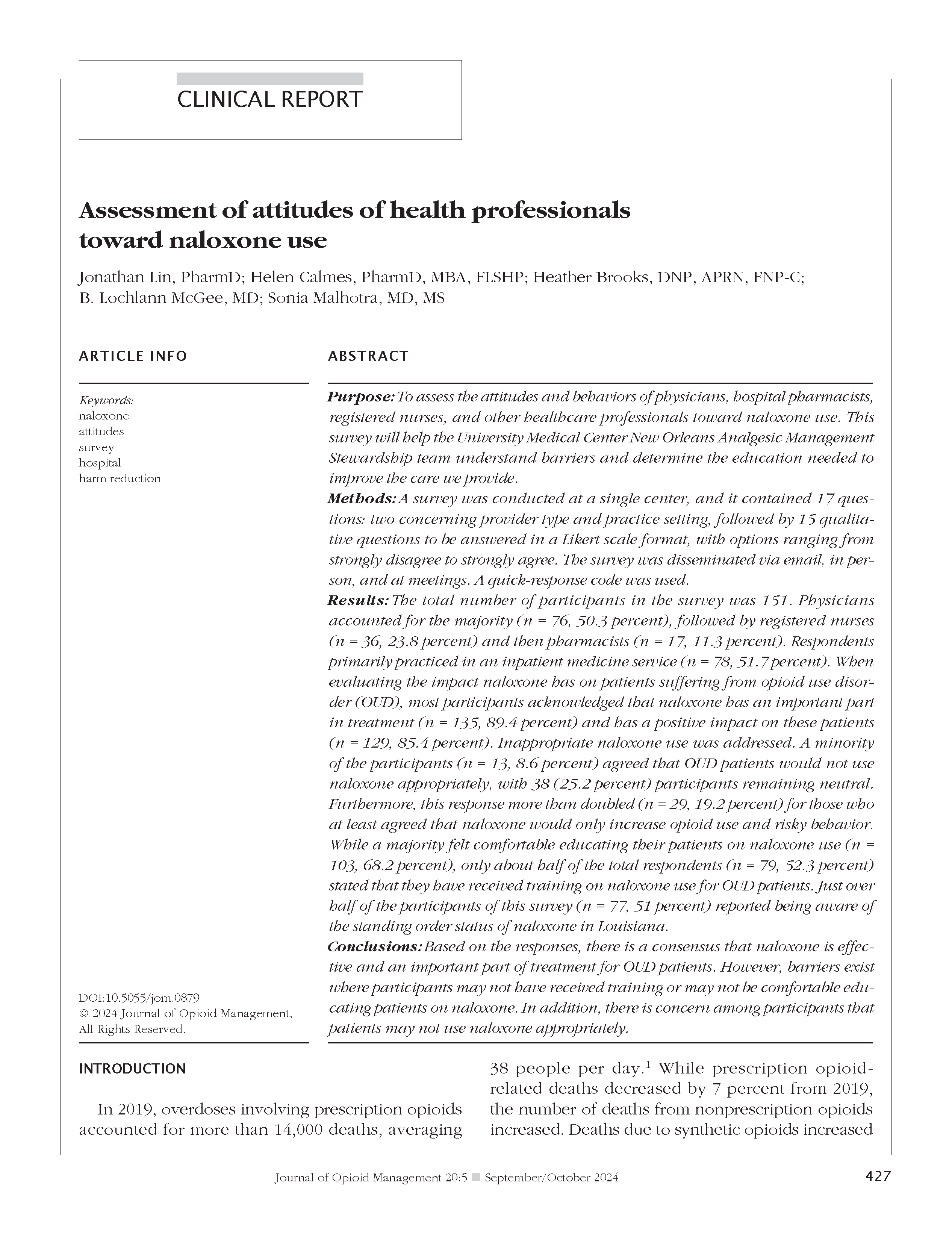Assessment of attitudes of health professionals toward naloxone use
DOI:
https://doi.org/10.5055/jom.0879Keywords:
naloxone, attitudes, survey, hospital, harm reductionAbstract
Purpose:To assess the attitudes and behaviors of physicians, hospital pharmacists, registered nurses, and other healthcare professionals toward naloxone use. This survey will help the University Medical Center New Orleans Analgesic Management Stewardship team understand barriers and determine the education needed to improve the care we provide.
Methods:A survey was conducted at a single center, and it contained 17 questions: two concerning provider type and practice setting, followed by 15 qualitative questions to be answered in a Likert scale format, with options ranging from strongly disagree to strongly agree. The survey was disseminated via email, in person, and at meetings. A quick-response code was used.
Results:The total number of participants in the survey was 151. Physicians accounted for the majority (n = 76, 50.3 percent), followed by registered nurses (n = 36, 23.8 percent) and then pharmacists (n = 17, 11.3 percent). Respondents primarily practiced in an inpatient medicine service (n = 78, 51.7 percent). When evaluating the impact naloxone has on patients suffering from opioid use disorder (OUD), most participants acknowledged that naloxone has an important part in treatment (n = 135, 89.4 percent) and has a positive impact on these patients (n = 129, 85.4 percent). Inappropriate naloxone use was addressed. A minority of the participants (n = 13, 8.6 percent) agreed that OUD patients would not use naloxone appropriately, with 38 (25.2 percent) participants remaining neutral. Furthermore, this response more than doubled (n = 29, 19.2 percent) for those who at least agreed that naloxone would only increase opioid use and risky behavior. While a majority felt comfortable educating their patients on naloxone use (n = 103, 68.2 percent), only about half of the total respondents (n = 79, 52.3 percent stated that they have received training on naloxone use for OUD patients. Just over half of the participants of this survey (n = 77, 51 percent) reported being aware of the standing order status of naloxone in Louisiana.
Conclusions:Based on the responses, there is a consensus that naloxone is effective and an important part of treatment for OUD patients. However, barriers exist where participants may not have received training or may not be comfortable educating patients on naloxone. In addition, there is concern among participants that patients may not use naloxone appropriately.
References
CDC: Prescription opioid data. 2021. Available at https://www.cdc.gov/drugoverdose/data/prescribing.html. Accessed September 4, 2021.
Adapt Pharma, Inc.: Narcan®. Radnor, PA: Adapt Pharma, Inc., 2015.
PDAPS: Prescription drug abuse policy system. 2017. Available at https://pdaps.org/datasets/laws-regulating-administration-of-naloxone-1501695139. Accessed September 4, 2021.
CDC: Vital signs, naloxone. 2019. Available at https://www.cdc.gov/vitalsigns/naloxone/index.html. Accessed September 4, 2021.
Office of the Surgeon General: US Surgeon General's advisory on naloxone and opioid overdose. 2018. Available at https://www.hhs.gov/surgeongeneral/priorities/opioids-and-addiction/naloxone-advisory/index.html. Accessed December 15, 2020.
Doe-Simkins M, Quinn E, Xuan Z, et al.: Overdose rescues by trained and untrained participants and change in opioid use among substance-using participants in overdose education and naloxone distribution programs: A retrospective cohort study. BMC Public Health. 2014; 14: 297. DOI: https://doi.org/10.1186/1471-2458-14-297
Jones JD, Campbell A, Metz VE, et al.: No evidence of compensatory drug use risk behavior among heroin users after receiving take-home naloxone. Addict Behav. 2017; 71: 104-106. DOI: https://doi.org/10.1016/j.addbeh.2017.03.008
McClellan C, Lambdin BH, Ali MM, et al.: Opioid-overdose laws association with opioid use and overdose mortality. Addict Behav. 2018; 86: 90-95. DOI: https://doi.org/10.1016/j.addbeh.2018.03.014
Rees DI, Sabia JJ, Argys LM, et al.: With a little help from my friends: The effects of naloxone access and good Samaritan laws on opioid-related deaths. Working Paper No. 23171. 2017. Available at http://www.nber.org/papers/w23171. Accessed March 28, 2024. DOI: https://doi.org/10.3386/w23171
Kline A, Mattern D, Cooperman N, et al.: A blessing and a curse: ‘Opioid users’ perspectives on naloxone and the epidemic of opioid overdose. Subst Use Misuse. 2020; 55(8): 1280-1287. DOI: https://doi.org/10.1080/10826084.2020.1735437
Drainoni ML, Koppelman EA, Feldman JA, et al.: Why is it so hard to implement change? A qualitative examination of barriers and facilitators to distribution of naloxone for overdose prevention in a safety net environment. BMC Res Notes. 2016; 9(1): 465. DOI: https://doi.org/10.1186/s13104-016-2268-z
Bessen S, Metcalf SA, Saunders EC, et al.: Barriers to naloxone use and acceptance among opioid users, first responders, and emergency department providers in New Hampshire, USA. Int J Drug Policy. 2019; 74: 144-151. DOI: https://doi.org/10.1016/j.drugpo.2019.09.008
Freeman PR, Goodin A, Troske S, et al.: Pharmacists' role in opioid overdose: Kentucky pharmacists' willingness to participate in naloxone dispensing. J Am Pharm Assoc (2003). 2017; 57(2s): S28-S33. DOI: https://doi.org/10.1016/j.japh.2016.12.064
Thakur T, Frey M, Chewning B: Pharmacist roles, training, and perceived barriers in naloxone dispensing: A systematic review. J Am Pharm Assoc (2003). 2020; 60(1): 178-194. DOI: https://doi.org/10.1016/j.japh.2019.06.016
Rudolph SE, Branham AR, Rhodes LA, et al.: Identifying barriers to dispensing naloxone: A survey of community pharmacists in North Carolina. J Am Pharm Assoc (2003). 2018; 58(4S): S55-S58.e3. DOI: https://doi.org/10.1016/j.japh.2018.04.025

Published
How to Cite
Issue
Section
License
Copyright 2005-2025, Weston Medical Publishing, LLC and Journal of Opioid Management. All Rights Reserved.










